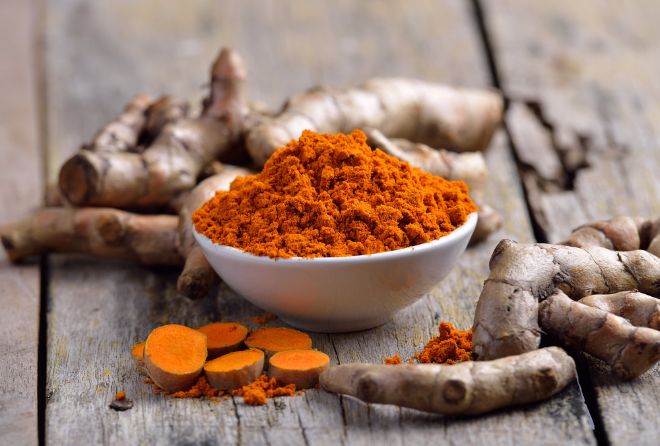Turmeric is a spice typically used in Asian food - and if you've ever had curry you've had tumeric. The spice is used in curry to give it it's renowned warm, bitter taste and color. The spice is used to color many foods actually - including mustard, butters and cheeses. Turmeric has a lot more going for it than it's taste and color though.
Turmeric is derived from the turmeric root plant and it's world renowned for it's all natural healing properties. Turmeric contains a chemical called curcumin which is thought to decrease inflammation. For this reason, turmeric has been used in Chinese and Indian systems of medicine for centuries.
Advertisement
Benefits of turmeric
Curcumin, which holds the anti inflammatory properties of turmeric, is actually found in the pigment of the spice. WH Foods explains that in some studies, "curcumin's anti-inflammatory effects have been shown to be comparable to the potent drugs hydrocortisone and phenylbutazone as well as over-the-counter anti-inflammatory agents such as Motrin". And a major benefit of turmeric is that it is non toxic, so it doesn't produce the same side effects like ulcers, or decreased white blood cell count, which are associated with drugs.
Because of it's healing properties, turmeric has been used for centuries to treat a wide variety of conditions which include:
according to WebMD and WH Foods
according to WebMD and WH Foods
Itchy skin, colds, headaches, arthritis, heartburn, joint pain, stomach pain, Crohn's disease and ulcerative colitis, bypass surgery, hemorrhage, diarrhea, intestinal gas, stomach bloating, loss of appetite, jaundice, liver problems, Helicobacter pylori (H. pylori) infection, stomach ulcers, irritable bowel syndrome (IBS), cystic fibrosis, gallbladder disorders, high cholesterol, a skin condition called lichen planus, skin inflammation from radiation treatment, fatigue.
Sometimes, turmeric is also applied directly to the skin to treat: pain, ringworm, sprains and swellings, bruising, leech bites, eye infections, acne, inflammatory skin conditions and skin sores, soreness inside of the mouth, infected wounds, and gum disease.
6 ways to use turmeric
1. Add this delicious spice to your scrambled eggs and frittatas.
The Kitchn says just a pinch will add a nice subtle flavor to your eggs, and add a familiar color. For this reason, it's a great way to introduce this healing spice into your diet.
The Kitchn says just a pinch will add a nice subtle flavor to your eggs, and add a familiar color. For this reason, it's a great way to introduce this healing spice into your diet.
2. Put it in soup.
Today suggests adding 1-2 teaspoons to just about any soup recipe. The turmeric will add a deep golden hue to it, making it taste and look even more delicious.
Today suggests adding 1-2 teaspoons to just about any soup recipe. The turmeric will add a deep golden hue to it, making it taste and look even more delicious.
3. Blend it into a smoothie.
You can use fresh turmeric or ground spice to add a kick of healthy benefits, and just a bit of flavor to your fresh juices or smoothies. The Kitchn says not to worry though - the flavor of the turmeric doesn't overpower the rest of your smoothy because it's masked pretty well by the other ingredients.
You can use fresh turmeric or ground spice to add a kick of healthy benefits, and just a bit of flavor to your fresh juices or smoothies. The Kitchn says not to worry though - the flavor of the turmeric doesn't overpower the rest of your smoothy because it's masked pretty well by the other ingredients.
4. Make a turmeric tea.
The Kitchn suggests taking turmeric, milk and honey and simmering it in nice hot water to make an earthy tea. You can also add a pinch to any other tea's you make yourself from home.
The Kitchn suggests taking turmeric, milk and honey and simmering it in nice hot water to make an earthy tea. You can also add a pinch to any other tea's you make yourself from home.
5. Grate fresh turmeric into your stir fry.
Today says you can add 1-2 teaspoons of freshly grated turmeric to your stir-fry for a punch of added freshness. Simply sprinkle it in while you're sautéing the veggies.
Today says you can add 1-2 teaspoons of freshly grated turmeric to your stir-fry for a punch of added freshness. Simply sprinkle it in while you're sautéing the veggies.
Advertisement
6. Amp up your pumpkin dishes.
Today says adding fresh turmeric to your pumpkin pie, muffins, and bread is going to bring out more amazing flavors in the dish and add a beautiful color. Simply stir in a teaspoon of fresh grated turmeric into your batter, then bake like you normally would.
Today says adding fresh turmeric to your pumpkin pie, muffins, and bread is going to bring out more amazing flavors in the dish and add a beautiful color. Simply stir in a teaspoon of fresh grated turmeric into your batter, then bake like you normally would.


